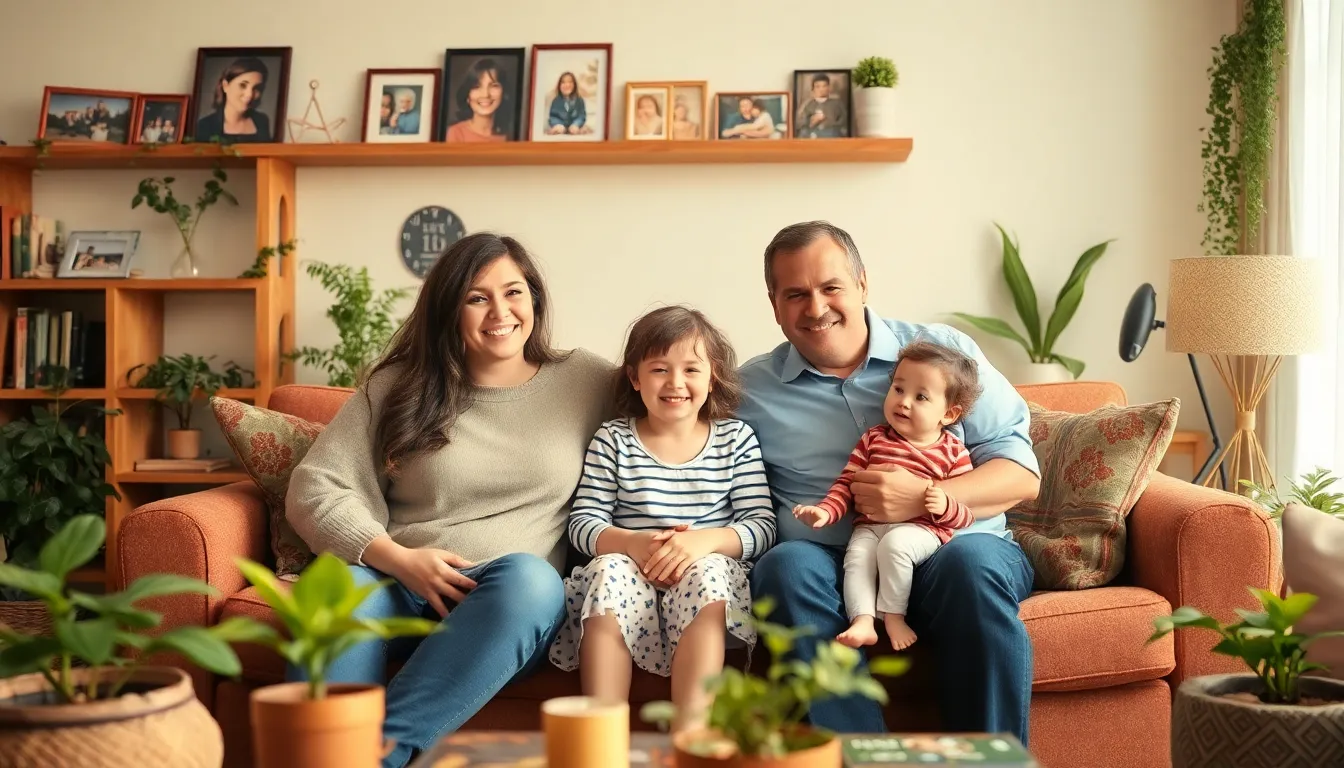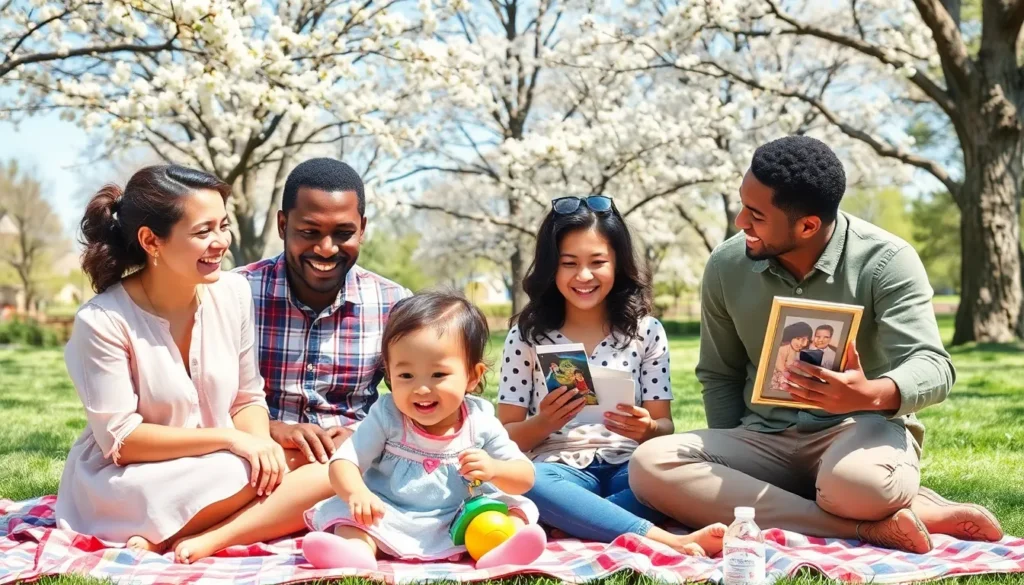Table of Contents
ToggleAdoption visitation might sound like a serious topic, but it doesn’t have to be all business and no fun. Imagine a world where families expand, connections grow, and everyone gets a chance to share a laugh—yes, even during those heartfelt visits. These moments aren’t just about paperwork and protocols; they’re about building relationships that can last a lifetime.
Understanding Adoption Visitation
Adoption visitation serves as a key element in nurturing relationships among adoptive families and birth families. It fosters connections and helps create a supportive environment for the child.
Definition of Adoption Visitation
Adoption visitation involves scheduled meetings between birth parents and adoptive families after an adoption placement. It allows for ongoing contact, enabling children to maintain a relationship with their birth families. These visits can vary in frequency and setting, and they adapt based on the comfort level of all parties involved. A clear agreement often outlines the visitation process, ensuring everyone understands expectations and boundaries.
Importance of Adoption Visitation
Adoption visitation plays a crucial role in a child’s emotional development. It supports identity formation by allowing children to explore their roots. Children benefit from continued relationships with birth parents, which can provide insights into family history and cultural heritage. Additionally, adoptive families gain a broader perspective on their child’s background. Open communication during visits strengthens trust and cooperation among families, promoting positive experiences for everyone involved.
Types of Adoption Visitation

Adoption visitation can take various forms, primarily categorized as open and closed adoption visitation. Each type serves unique needs and preferences for both birth families and adoptive families.
Open Adoption Visitation
Open adoption visitation allows for ongoing contact between birth parents and adoptive families. In this arrangement, birth parents often have the opportunity to participate in a child’s life, promoting emotional connections. Scheduled visits might include family gatherings, special events, or regular meetings that maintain relationships. Transparency plays a crucial role, as communication fosters trust and understanding. This type of visitation benefits children by providing insight into their origins and heritage, enhancing their sense of identity. As a child grows, open visitation can adapt to their needs and comfort levels, ensuring ongoing support and love from both families.
Closed Adoption Visitation
Closed adoption visitation typically involves limited or no contact between birth parents and adoptive families after placement. In this case, privacy concerns lead to a more formalized separation, where information shared remains confidential. Birth parents may relinquish contact voluntarily or as a part of the adoption process. This arrangement aims to protect both parties’ emotional well-being while providing stability for the child. While children may not have direct interactions with their birth families, adoptive parents often hold responsibility for communicating family history and cultural context. Closed adoption visitation requires careful consideration, prioritizing the child’s best interests as they navigate their identity within their adoptive family.
Legal Considerations
Legal aspects play a crucial role in adoption visitation, impacting custody agreements and state-specific regulations. Understanding these factors ensures a smoother experience for all parties involved.
Custody and Visitation Rights
Custody agreements determine the rights of biological and adoptive parents. Courts grant visitation rights based on the child’s best interests, supporting their emotional well-being. Open adoption arrangements typically allow birth parents access to their child. This access can fluctuate with the child’s age and needs. Adoptive families may also seek to establish clear visitation parameters to promote a nurturing environment. Established visitation arrangements should be documented to prevent misunderstandings. Consistent communication strengthens relationships between both families.
State Laws and Regulations
State laws governing adoption visitation vary significantly across jurisdictions. Different states establish unique guidelines regarding open and closed adoption practices. It’s essential for families to familiarize themselves with the relevant laws in their state. Legal requirements often dictate how visitation schedules are set up and enforced. In some states, mediation may facilitate visitation agreements, especially in disputes. Individual circumstances can also influence legal considerations. Understanding your state’s legal landscape ensures compliance and promotes positive outcomes for children and families.
Emotional Impact
Adoption visitation fosters emotional connections that benefit everyone involved. Families experience significant advantages as they navigate these interactions.
Benefits for Adoptive Families
Adoptive families gain insight into the child’s background and heritage through visitation. These meetings create opportunities for adoptive parents to understand their child’s emotions better. Frequent visits enhance the child’s sense of belonging by involving birth families in their lives. Parents often find comfort in knowing that their child maintains connections with their origins. Communication during visits enhances trust and strengthens the overall family unit. Emotional support flourishes as relationships develop between adoptive and birth families.
Benefits for Birth Families
Birth families experience emotional fulfillment by staying connected with their child. The chance to participate in their child’s life helps mitigate feelings of loss and guilt. Regular interaction allows birth parents to witness their child’s growth and happiness firsthand. Knowing adoptive families provide love and support brings comfort to birth parents. Visits create a safe space for sharing cultural and familial traditions, enriching the child’s identity. Emotional healing occurs when birth families engage positively in this process, knowing their impact persists.
Best Practices for Adoption Visitation
Adoption visitation requires thoughtful planning and execution to foster positive relationships. Following best practices helps create a nurturing environment for all families involved.
Preparing for Visits
Preparation enhances the adoption visitation experience. Establish clear expectations by discussing the purpose and goals of the visit. Creating a comfortable atmosphere sets the tone for meaningful connections. Gathering relevant items, such as photographs or cultural artifacts, allows families to share important aspects of their histories. Additionally, scheduling visits in a familiar setting promotes relaxation and openness. Keeping a flexible mindset helps everyone navigate potential challenges that may arise during the visit.
Conducting Successful Visits
Conducting successful visits relies on open communication and respect. Engaging in active listening demonstrates care and fosters trust among participants. Staying attuned to the child’s emotional needs allows parents to adjust the visit as necessary. Sharing joyful moments, such as stories or activities, brings families closer together. Setting boundaries beforehand establishes a sense of security for everyone. Prioritizing the child’s best interests remains paramount throughout the visit. Emphasizing positive interactions contributes to a supportive environment, enhancing the overall experience for all parties involved.
Adoption visitation plays a vital role in shaping the emotional landscape of all parties involved. By fostering connections between birth and adoptive families, these visits create a supportive environment that benefits the child’s development. The emotional fulfillment derived from these interactions enriches the lives of both families, promoting understanding and healing.
Navigating the complexities of adoption visitation requires thoughtful planning and open communication. Establishing clear expectations and boundaries ensures a positive experience for everyone. Ultimately, the commitment to nurturing these relationships helps children develop a strong sense of identity and belonging, making adoption visitation an invaluable aspect of the adoption journey.





